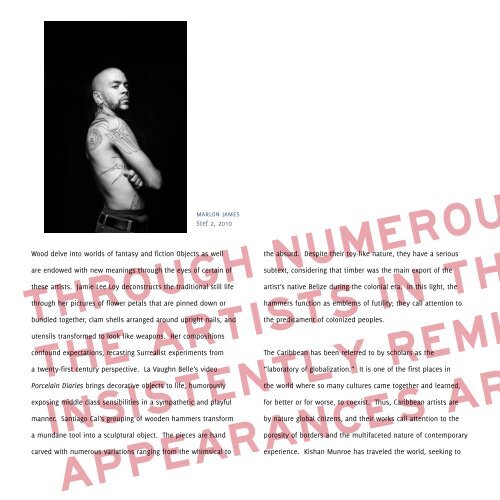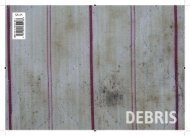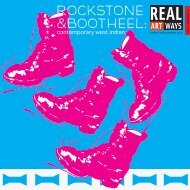Wrestling with the Image: Caribbean Interventions - Blue Curry
Wrestling with the Image: Caribbean Interventions - Blue Curry
Wrestling with the Image: Caribbean Interventions - Blue Curry
Create successful ePaper yourself
Turn your PDF publications into a flip-book with our unique Google optimized e-Paper software.
artists <strong>the</strong>mselves, allows us to reflect on our own assumptions<br />
and preconceptions on <strong>the</strong> nature of images, <strong>the</strong> meaning of<br />
The production of content, however problematized by <strong>the</strong><br />
Wood delve into worlds of fantasy and fiction Objects as well<br />
are endowed <strong>with</strong> new meanings through <strong>the</strong> eyes of certain of<br />
THROUGH NUMEROUS VISUAL TROPES,<br />
<strong>the</strong>se artists. Jamie Lee Loy deconstructs <strong>the</strong> traditional still life<br />
through her pictures of flower petals that are pinned down or<br />
bundled toge<strong>the</strong>r, clam shells arranged around upright nails, and<br />
utensils transformed to look like weapons. Her compositions<br />
THE ARTISTS IN THE EXHIBITION<br />
confound expectations, recasting Surrealist experiments from<br />
a twenty-first century perspective. La Vaughn Belle’s video<br />
marlon james<br />
Stef 2, 2010<br />
Porcelain Diaries brings decorative objects to life, humorously<br />
INSISTENTLY REMIND US THAT<br />
exposing middle class sensibilities in a sympa<strong>the</strong>tic and playful<br />
manner. Santiago Cal’s grouping of wooden hammers transform<br />
a mundane tool into a sculptural object. The pieces are hand<br />
carved <strong>with</strong> numerous variations ranging from <strong>the</strong> whimsical to<br />
<strong>the</strong> absurd. Despite <strong>the</strong>ir toy-like nature, <strong>the</strong>y have a serious<br />
subtext, considering that timber was <strong>the</strong> main export of <strong>the</strong><br />
artist’s native Belize during <strong>the</strong> colonial era. In this light, <strong>the</strong><br />
hammers function as emblems of futility; <strong>the</strong>y call attention to<br />
<strong>the</strong> predicament of colonized peoples.<br />
The <strong>Caribbean</strong> has been referred to by scholars as <strong>the</strong><br />
“laboratory of globalization.” It is one of <strong>the</strong> first places in<br />
<strong>the</strong> world where so many cultures came toge<strong>the</strong>r and learned,<br />
for better or for worse, to coexist. Thus, <strong>Caribbean</strong> artists are<br />
by nature global citizens, and <strong>the</strong>ir works call attention to <strong>the</strong><br />
porosity of borders and <strong>the</strong> multifaceted nature of contemporary<br />
experience. Kishan Munroe has traveled <strong>the</strong> world, seeking to<br />
connect <strong>with</strong> peoples of different cultures and locate <strong>the</strong> ties<br />
that bind all of humanity toge<strong>the</strong>r. Hew Locke and Jean-Ulrick<br />
Désert take a more cynical view of globalization, offering bodies<br />
of work that challenge and ridicule colonial and neo-colonial<br />
power structures. Abigail Hadeed and Roshini Kempadoo reflect<br />
on <strong>the</strong> experience of migration through <strong>the</strong> filter of nostalgia.<br />
Hadeed sought out <strong>the</strong> Afro-<strong>Caribbean</strong> peoples who migrated to<br />
Costa Rica and documented <strong>the</strong>ir continuing connection to <strong>the</strong><br />
Pan-African movement of Marcus Garvey. Kempadoo turned her<br />
attention to <strong>the</strong> experience of diasporic communities in England<br />
and created a series of digitally altered prints that reflected on<br />
<strong>the</strong> solitude and isolation that accompanies <strong>the</strong> immigrant.<br />
Though this essay began by evoking <strong>the</strong> most jaded tropical<br />
image, I hope it has been clear that my intention has not<br />
been to advocate for more beachscapes but ra<strong>the</strong>r to identify<br />
<strong>the</strong> common threads that bind <strong>the</strong> dizzyingly dynamic visual<br />
production of contemporary <strong>Caribbean</strong> artists. For too long, <strong>the</strong><br />
region has been subjected to stereotype, but it is encouraging<br />
that artists never<strong>the</strong>less choose to engage local subject matter—<br />
broadly understood—instead of retreating into a hermeticist<br />
visual language that would have <strong>the</strong>m deny <strong>the</strong>ir surroundings<br />
APPEARANCES ARE DECEIVING<br />
and backgrounds altoge<strong>the</strong>r.<br />
place, <strong>the</strong> articulation of difference, and <strong>the</strong> construction of <strong>the</strong><br />
past and present. Whe<strong>the</strong>r <strong>the</strong>se images delight, frustrate, or<br />
disgust, <strong>the</strong>y provoke a reaction, <strong>the</strong>reby challenging us to a<br />
wrestling match.<br />
With infinite gratitude to Maria Leyva and Christopher Cozier<br />
for <strong>the</strong>ir support and wisdom.<br />
1. Kaira M. Cabañas, “If <strong>the</strong> Grid Is <strong>the</strong> New Palm Tree of Latin American Art,”<br />
Oxford Art Journal 33.3 (2010): 367.<br />
2. Silvio Torres Saillant, An Intellectual History of <strong>the</strong> <strong>Caribbean</strong><br />
(NewYork: Palgrave Macmillan, 2006), 7<br />
WRESTLING WITH THE IMAGE CARIBBEAN INTERVENTIONS<br />
25




